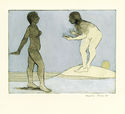
19th, 20th & 21st Century Fine Prints
707-546-7352 · fax 707-546-7924 · web: www.annexgalleries.com · email: artannex@aol.com
William Theophilus Brown Biography
William Theophilus Brown
American
1919–2012
Biography
William Theophilus Brown, painter and printmaker, was born on April,7, 1919 in Moline, Illinois. He received his BFA from Yale University in 1941. Following his service in World War II, Brown traveled to Paris in 1942, where he studied under Fernand Leger and Amedee Ozenfant. It was upon his return to New York that he began serious study of Abstract Expressionism, and he befriended Rothko and de Kooning, who would become a strong influence on Brown’s work. He also took inspiration from those he met on his frequent visits to Paris: artists Pablo Picasso, Georges Bracque, and Alberto Giacometti, as well as composers Igor Stravinski, John Cage, and Samuel Barber.
As his style matured, he abandoned Abstract Expressionism to focus on figurative work. In 1952 he moved to California to study at the University of California, Berkeley, where he received his MFA. He would soon become associated with the Bay Area Figurative movement, alongside contemporaries Diebenkorn and Wonner (who would later become his partner), and would have his first solo exhibition at the San Francisco Museum of Modern Art in 1957. In the early 1960s Brown and Wonner moved to Malibu and became a part of the Southern California arts scene, before returning to the Bay Area and settling in San Francisco.
Brown taught at the University of California at Davis, CA between 1975 and '76. He died in San Francisco on February 8, 2012.
Although Brown’s work is exemplary of the Figurative movement, his artistic development and journey are closely associated with that of his partner, Paul Wonner. Both artists were included in the historic Paul Mills exhibition at the Oakland Art Museum, “Contemporary Bay Area Figurative Painting,” in 1957. Brown continued his exploration of the figure well into the 1960’s, experimenting with abstraction, light and color.





